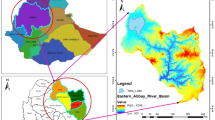Abstract
More than 60 catchments from Northern Belgium ranging in size from 16 to 3160 km2 have been studied by means of a physically-based stochastic water balance model. The parameter values derived from calibration of the model were regionally mapped for the study region. Associations between model parameters and basin lithological characteristics were established and tested. The results show that the simple conceptual monthly water balance model with three parameters for actual evapotranspiration, slow and fast runoff is capable either to generate monthly streamflow at ungauged sites or to extend river flow at gauged sites. This allows a fairly accurate estimation of monthly discharges at any location within the region.
Similar content being viewed by others
References
Aston, A.R. and F.X. Dunin, 1979. ‘Shoalhaven land use hydrology’. Proceedings of the Hyprology and Water Resources Symposium. Perth, 150–155.
Beven, K.J., 1989. ‘Changing ideas in hydrology — The case of physically-based models’. Journal of Hydrology, 105, 157–172.
Huybrechts, W., A. Van der Beken and G.L. Vandewiele, 1990. ‘Water balance computations for larger regions based on calibrated models of gauged catchments’. Hydrological Research Basins and the Environment: Proceedings of the International Conference, 24–28 Sept., Wageningen, 21–28.
Jarboe, J.E. and C.T. Haan, 1974. ‘Calibrating a water yield model for small ungaged watersheds’. Water Resources Research, 10(2), 256–262.
Jones, J.R., 1976. ‘Physical data for catchment models’. Nordic Hydrology, 7, 245–264.
Magette, W.L., V.O. Shanholtz and J.C. Carr, 1976. ‘Estimating selected parameters for the Kentucky watershed model from watershed characteristics’. Water Resources Research, 12(3), 472–476.
Nash, J.E. and J.V. Sutcliffe, 1970. ‘River flow forecasting through conceptual models. Part 1 — A discussion of principles’. Journal of Hydrology, 10, 282–290.
Riggs, H.C., 1973. ‘Regional analyses of streamflow characteristics’. Techniques of Water Resources Investigations, Book 4, Ch. B3, US. Geological Survey, Washington, D.C.
Vandewiele, G.L., C.Y. Xu and Ni-Lar-Win, 1991. ‘Regionalisation of model types and parametervalues of parsimonious monthly rainfall-runoff models’. To be presented in European Conference: Advances in Water Resources Technology, 20–23 March, 1991, Athens.
Weeks, W.D. and N.M. Ashkanasy, 1983. ‘Regional parameters for the Sacramento Model: A case study’. Hydrology and Water Resources Symposium, Hobart.
Xu, C.Y., 1988. ‘Regional study of monthly rainfall-runoff models’. MSc. thesis, Laboratory of Hydrology, Vrije Universiteit Brussel, Brussels.
Author information
Authors and Affiliations
Rights and permissions
About this article
Cite this article
Vandewiele, G.L., Xu, CY. & Huybrechts, W. Regionalisation of physically-based water balance models in Belgium. Application to ungauged catchments. Water Resour Manage 5, 199–208 (1991). https://doi.org/10.1007/BF00421989
Issue Date:
DOI: https://doi.org/10.1007/BF00421989




